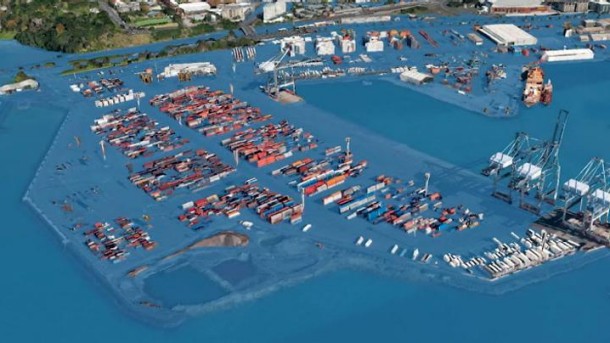The Parliamentary Commissioner for the Environment has published a new study on sea level rise. Last time she reviewed the science behind the issue, now she is looking at the risks that a rising tide poses to our country – particularly houses, businesses and roads.
We have built our country on the assumption that the sea level stays the same. While that may have been the case through most of the history of humankind, it is no longer so. The sea level is rising and will continue to rise, increasing the frequency of flood events and rendering some homes, businesses and roads useless. We need to start preparing for this completely predictable event now.
Sea level rise
The sea level is already rising – it has already risen 20 cm since 1880 and is predicted to rise a further 30cm within the next 50 years. The long-term prognosis depends on how much emissions we chug out in the meantime, but predictions for sea level rise for the rest of the century are between 40cm and 1m. Regardless, our coastlines are changing and will continue to change. As the Parliamentary Commissioner for the Environment points out, we need to prepare.
Here’s a fact to help sharpen your mind. Think of the highest known sea level in measured history – this is known as a 100-year event. For Aucklanders this was back in 2011, and Wellingtonians will no doubt remember the storm of 2013. Well, within the next 50 years (if not earlier) that sort of event will happen every year in Wellington, and every 4 years in Auckland.
What’s the Damage?
It is hard to be certain about nature. Some areas have natural protection, and some coastal areas may erode faster than others. Some areas may put in artificial defences, but these are proving expensive, and are not a permanent solution. Earthquakes can alter the height of land, as we have seen in Christchurch.
However, according to NIWA modelling a 50cm sea level rise – which for many of us is possible within our lifetime unless we really get on top of emissions – would swamp about 9,000 homes. The total cost of replacing those homes and other buildings is estimated at $3 billion. That doesn’t include the stuff below ground, which as they have found in Christchurch is very expensive to replace.
Worst hit will be South Dunedin (2,684 homes, 116 businesses and 35km of roads), Napier (1,321 homes, 12 businesses and 37km of roads) and Christchurch (901 homes, 5 businesses and 40km roads). Looking at history this shouldn’t really come as a surprise – all these areas were built on wetlands, although some of that area in Christchurch is now unoccupied following the earthquake.
The maps below illustrate the stark issues facing South Dunedin and Christchurch.


As the sea level continues to rise the numbers of homes, businesses and roads threatened increase accordingly – a 1.5m rise will submerge 10,000 homes in Christchurch, 8,000 in Napier, 5,000 in Wellington and 3,600 in Dunedin. A sea level rise of this magnitude would create $20 billion worth of damage. It is hard to know how long it would take to see a 1.5m sea level rise but the latest evidence suggest that it could be possible in the lifetimes of children being born now. Has climate change got your attention yet?
So what do we do?
For many this will serve as a wake up call on climate change – that New Zealand needs to take the issue seriously and start reducing our emissions.
However even if we take action on reducing emissions, the sea level will continue to rise for some time yet – some warming is already in the bank. The question is what do we do to prepare?
Most of the Parliamentary Commissioner for the Environment’s recommendations are a serve to the Ministry for the Environment and Minister Nick Smith. For too long governments have given the hospital pass of sea level rise to local authorities to sort out. As we have seen in Christchurch and Kapiti the Councils that have dared stick their neck out on the issue have ended up getting hammered. Greater guidance from central government is needed on how to manage planning in coastal zones.
But the really big issue to resolve is who pays when the inevitable disaster strikes. Sea level rise isn’t an Act of God, it is a completely predictable human created event. The question isn’t if it will happen but when, and by that stage the insurance companies will be long gone.
We have previously pointed out that when problems arise, bach owners shouldn’t expect government and councils to bail them out for their poor decisions. The Commissioner has rightly pointed out that some of the communities involved are not rich bach owners, they have been settled for over 100 years and for many their family home is at threat.
This issue needs some urgent thought to develop a solution that is fair, affordable, and ensures that anyone buying or developing in coastal zones from now on does so at their own (or the bank’s) risk. The Commissioner has sensibly recommended that the Minister of Finance establish a working group to sort this out. The ball is now in his court.

